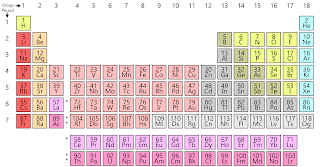Nitrogen, a chemical element with the symbol Si and atomic number 14, is a colorless liquid, gas, or solid. At normal temperature and pressure, two atoms of nitrogen bind together to form colorless and odorless dinitrogen (N2) gas. N2 forms about 78% of the earth’s atmosphere which makes it the most abundant uncombined element on the earth's surface.
In chemical
laboratory, dinitrogen can be prepared by treating an aqueous solution of
ammonium chloride and sodium nitrite.
NH4Cl + NaNO2 → N2 + NaCl + 2 H2O
You are here to
know valence electrons of the nitrogen atom, aren’t you? Don’t worry along with nitrogen
valence electrons we will explain its valency also. But before that let’s have
some basic ideas about what these two terms are:
Difference Between Valence Electrons and Valency
Valence electrons
are the total number of electrons present in the outermost shell of an atom
(i.e. in outermost orbital). The valence electrons for a neutral atom are
always definite, it cannot be varied (more or less) in any condition for a
particular atom and may or may not be equal to its valency.
Valency is defined
as the total number of electrons an atom can lose, gain, or share at the time
of bond formation to get a stable electronic configuration i.e. to complete an
octet. The valency of an atom can be variable in different compounds or chemical
reactions due to the different bonding circumstances. Most of the time valency
varies/changes due to change in oxidation and reduction states.
Nitrogen (N) Valence Electrons
There are four
simple steps to find out the valence electrons for nitrogen atom which are:
Step 1: Find the
Atomic Number
To find out the
atomic number of nitrogen, we can use the periodic table. With the help of the
periodic table, we can easily see that the atomic number of nitrogen is 7. As
its atomic number is 7, it has 7 protons, and for neutral nitrogen, the number
of protons is always equal to the number of electrons i.e. has 7 electrons in
its nucleus.
Step 2: Write
Electron Configuration
Electron
configuration is the arrangement of electrons on the orbitals. The nitrogen
atom has a total of 7 electrons so, we have to put 7 electrons in orbitals. The
electrons will be placed in different orbitals according to the energy level:
[1s, 2s, 2p, 3s, 3p, 4s, 3d, 4p, 5s, 4d, 5p, 6s, 4f, 5d, 6p, 7s, 5f]. Now,
Nitrogen electron configuration N (7) = 1s22s22p3 (complete configuration).
= [He] 2s22p3 (condensed configuration).
Step 3: Determine
Valence Shell
As we know, the valence shell of an atom can be found from the highest number of principle quantum numbers which are expressed in the term of n, and in [He]2s22p3, the highest value of n is 2 so that the valence shell of nitrogen is 2s22p3.
Step 4: Find
Valence Electrons
The total number of electrons present in the valence shell of an atom are called valence electrons, and there are a total of five electrons present in the valence shell of nitrogen (2s22p3). Thus, nitrogen has five valence electrons.
Valency of Nitrogen (N)
There are many
different ways to find out the valency of an atom which reflects the ability of
an atom to bond with other atoms. Valence describes how easily an atom or a
free radical can combine with other chemical species. The valency of an atom is
determined based on the number of electrons lost, gained, or shared with
another atom at the time of bond formation.
An atom is said to
be stable when its outermost shells have eight electrons (except H & He).
If the total number of electrons in outermost shells is between one to four,
the atom has positive valency and if electrons are between four to eight, the
valency is calculated by subtracting from eight and valency will be zero. Atoms
having four outermost electrons possess both positive and negative valency, and
atoms having eight outermost electrons, valency will be zero (i.e. noble
gases).
Elements like nitrogen
can reach the stable state (nearest inert gas configuration [Ne]) by getting 3
electrons. So that the valency of nitrogen is 3 (trivalent).
Note: Basically, the valency of nitrogen is 5 but it does not have d subshell so that the valency
reduces to 3 from 5. For example, phosphorous pentachloride (PCl5) can exist as
phosphorus has d-orbitals but nitrogen pentachloride (NCl5) cannot exist. Although
nitrogen has 5 valence electrons only a maximum of three can take parts in
bond formation [example: NCl3, NH3].
In another sense, a
nitrogen atom can form a maximum of three covalent bonds in chemical bonding (For
example: NH3, NCl3, etc.), and that what valency is, the maximum ability to form
bonds with atoms at the time of chemical reactions.
We can also find
the valency of nitrogen with the help of the periodic table. As nitrogen
belongs to group 15 (5A or VA) along with nonmetal phosphorus (P), the
metalloids arsenic (As) and antimony (Sb), and the metal bismuth (Bi). These group elements are also called pnictogens. All these elements have a valency of 3.
Clarification: Valence electrons and valency are two different aspects. valence electrons mean total electrons present in the outermost shell of the element i.e. in the case of nitrogen , its valence electrons are 5.
But valency is the combining capacity of an element at the time of chemical bonding. so that valency cannot be negative or positive, it is just a number value between 0 to 7. In the case of nitrogen, valency is 3.



Post a Comment